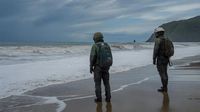Residents of Russia’s Far East and the wider Pacific region spent a tense Saturday after a powerful earthquake, measuring 7.4 on the Richter scale, struck near the east coast of the Kamchatka Peninsula on September 13, 2025. The quake, which hit in the early hours, was confirmed by the U.S. Geological Survey (USGS), which pinpointed the epicenter 111.7 kilometers (69.3 miles) east of Petropavlovsk-Kamchatsky at a depth of 39 kilometers. The China Earthquake Networks Center (CENC) also reported seismic activity, noting a 7.3-magnitude quake at 10:37 a.m. Beijing Time, with the epicenter at 53.05 degrees north latitude and 160.45 degrees east longitude, and a shallower depth of 20 kilometers. Despite the strength of the tremor, officials reported no immediate injuries or major damage.
In the immediate aftermath, the Pacific Tsunami Warning System briefly issued a warning for possible tsunami waves, raising alarms not just in Russia’s Kamchatka Peninsula but also across the Pacific, including as far away as Hawaii. According to the Associated Press, the alert was soon removed from the system’s website after further analysis. The Japan Meteorological Agency also issued warnings to coastal areas, advising of slight changes in sea levels but emphasizing that the likelihood of significant damage was minimal.
The Pacific Tsunami Warning Center (PTWC) in Hawaii was quick to respond. As reported by local outlets, the PTWC initially raised concerns about a potential tsunami that could impact the Pacific Islands, including Hawaii. Given Hawaii’s history and vulnerability to tsunamis, the warning sparked a period of uncertainty among residents and tourists. However, within 30 minutes, the PTWC confirmed that there was no tsunami threat to the Hawaiian Islands, providing much-needed relief. The agency’s rapid assessment was credited with preventing unnecessary panic and ensuring the public remained informed and safe.
The earthquake’s epicenter, located at coordinates 53.0 degrees north and 160.4 degrees east, sits in one of the world’s most tectonically active regions. Kamchatka is infamous for its frequent seismic and volcanic activity, being part of the Pacific Ring of Fire—a horseshoe-shaped zone notorious for earthquakes and eruptions. As noted by the USGS and other agencies, the Kamchatka Peninsula is considered the most tectonically earthquake-prone region globally. Its dramatic landscape, while breathtaking, is a constant reminder of the natural hazards that come with its geography.
This latest quake is not an isolated incident for Kamchatka. On July 20, 2025, the region experienced a series of five strong earthquakes, the largest also measuring 7.4 in magnitude. Despite these frequent tremors, the area remains sparsely populated, with Petropavlovsk-Kamchatsky serving as the main port city facing the Pacific Ocean. The city, though remote, is vital for the region and has so far managed to withstand the regular seismic activity with resilience.
For travelers and tourists drawn to Kamchatka’s wild beauty and adventure opportunities, the recent quake serves as a stark reminder of the importance of preparedness. The region’s appeal lies in its rugged terrain, active volcanoes, and rich biodiversity, but visitors are urged to remain vigilant and informed about potential natural disasters. The Hawaii Emergency Management Agency (HI-EMA) regularly updates public safety guidelines for tsunamis and earthquakes, including evacuation routes and designated safety zones. Tourists to Hawaii and other Pacific destinations are encouraged to familiarize themselves with local emergency procedures, stay updated on warnings, and heed official instructions during seismic events.
The Pacific Tsunami Warning Center’s swift and thorough response to the Kamchatka quake is a testament to the advancements in seismic monitoring and public safety communication. The PTWC monitors seismic activity across the Pacific and issues alerts when necessary, coordinating with agencies in affected regions to ensure timely dissemination of information. As the recent event demonstrated, rapid assessment and clear communication can dramatically reduce the risk of panic and help communities respond effectively to potential threats.
While the immediate threat to Hawaii and the wider Pacific region was ruled out, the incident underscored the interconnectedness of communities along the Pacific Rim. From Russia’s remote Kamchatka Peninsula to the beaches of Hawaii, seismic events in one part of the world can trigger alerts and concern thousands of miles away. It’s a reminder that, despite technological advances, nature’s power remains unpredictable and formidable.
Authorities in Russia, Japan, China, and the United States all played crucial roles in monitoring and responding to the earthquake. The USGS and CENC provided detailed seismic data, while the Pacific Tsunami Warning System and Japan Meteorological Agency issued and updated alerts as the situation developed. Their coordinated efforts ensured that residents and travelers received accurate, timely information, minimizing confusion and helping to maintain public safety.
For the people of Kamchatka, earthquakes are an unfortunate but familiar part of life. The region’s residents have adapted to the constant threat, building resilience and preparedness into their daily routines. Yet, as the recent quake demonstrated, vigilance remains essential. Even in the absence of major damage or casualties, each seismic event serves as a fresh reminder of the region’s volatility and the importance of readiness.
In the days following the quake, officials continued to monitor the region for aftershocks and potential secondary hazards. Emergency services remained on alert, and public information campaigns emphasized the need for ongoing preparedness. For now, life in Kamchatka and the wider Pacific has returned to a cautious normalcy, but the memory of the earth’s sudden movement lingers.
As the Pacific region moves forward, the lessons from the September 13 earthquake are clear: rapid response, clear communication, and public preparedness are the keys to minimizing the impact of natural disasters. Whether in Russia, Hawaii, or elsewhere along the Pacific Ring of Fire, staying informed and ready remains the best defense against the unpredictable forces beneath our feet.


